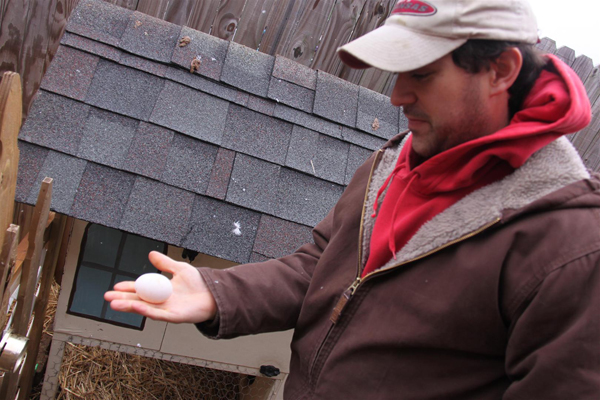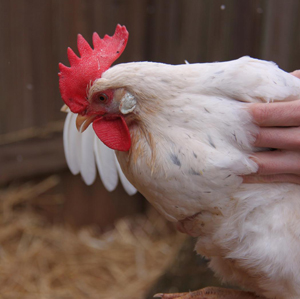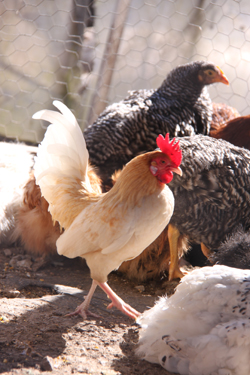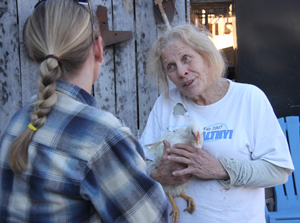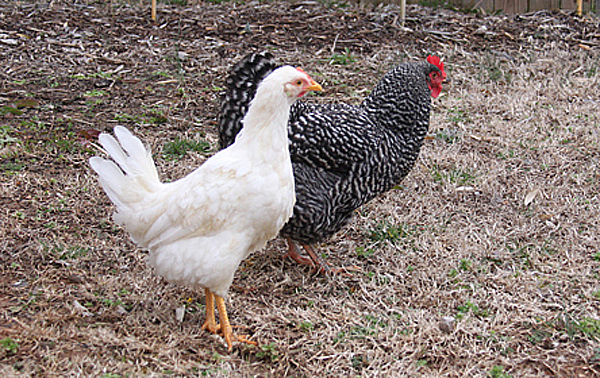
Chickens may not have a reputation as the best animals to keep in a suburban setting. They can be a little smelly, a little loud (if you have roosters) and do not make the smartest, most loving or cuddly pets. They can require some attention and nightly herding into a cage or coop.
Plus, it’s the 21st century. And we are a civilized society. This ain’t the backwoods. We can get our food in the sanitized and proper grocery or 24-hour big-box store, without having to be reminded that food actually comes from the dirt, or animals.
But eating local, and eating natural aren’t just trendy catchphrases for many, it’s a genuine belief that there’s a better way than continually consuming mass-scale, “factory”-produced, genetically modified, hormone-injected, months-old products, and that working outside, alongside God and the plants, animals and elements for food, is something to take pride in.
One Murfreesboro resident has proven you don’t need a large farm in order to have a successful egg-gathering operation.
Kyle Hillis keeps six chickens, the maximum allowed by city ordinance on a single lot, in his modest Murfreesboro backyard. And after making his place a little more chicken-friendly over the past few years, he now has more eggs than he can eat.
A small house, maybe four feet high and a couple feet square, split into two sides and two levels, accommodates the ladies comfortably.
“They like to have somewhere up high to sit,” Hillis says, pointing to a couple of hens on the top level of the chicken house.
A timed lighting system in their structure means the chickens get some artificial daylight in early March beginning at 4 a.m.
“I trick them a little bit, and make them think it’s summertime,” says Hillis. “The white Leghorn and the Rhode Island Red lay all the time. Some breeds don’t lay very much when it’s colder.”
Directly outside of the coop, the chickens have a small penned area to dine and socialize in, but often during the day can roam in the (not even totally fenced-in) yard.
“If you keep feeding them, and they realize you’re not going to eat them, they’ll stay around,” Hillis says.
In the summer, water from the air conditioning unit drips into a dish for the birds. In the winter, an electrified bucket contains some water for the flock.
“I rigged this bucket up so it won’t freeze. It doesn’t get very hot, just keeps it barely above freezing,” he says. The bucket hangs slightly off the ground, offering a chicken nipple, a small watering device that has increased in popularity lately, below.
“Chicken nipples are the way everyone’s going; when I leave water on the ground they poop in it, they step in it. Plus they get curious about the red (color of the nipple),” Hillis says.
He approaches clean-up duty with a good attitude, actually seeing the value in the birds’ waste.
“I’ll take the board from the coop and just scrape it in the garden,” he says.
The plentiful eggs must be worth it. The chicken-keeper can tell which of his birds has laid a particular egg just from its appearance. The Ameraucana lays light blue eggs, his Welsummer lays speckled brown eggs, the White Leghorn lays white eggs while the Rhode Island Red lays brown eggs, close in color to the ones of the French Grey, but distinct enough to tell a difference.
Some bird lovers fancy having some of the more odd-looking and colorful birds running around, and that’s fine, Hillis says, but advises those considering keeping chickens to have a goal, whether that may be producing as many eggs as possible, or simply having beautiful, fun-looking birds hanging out back.
“I would say get five or six chickens that lay all the time. Some of the fancy breeds won’t lay as much. I spend $30 on feed a month. Sometimes, I’m like, ‘What the heck! I’m feeding this chicken, cleaning up its poop, and it’s not giving me anything,’” he says. “That’s why farmers will find a breed they like, White Leghorn or whatever, and get 50 or 100 of them, instead of having all kinds of different chickens running around. It’s all about production for them,” he says.
Judy Wood of Poultry Hollow Hatchery agrees that Leghorns and Rhode Island Reds are great layers, but says she wouldn’t suggest those breeds for close quarters, particularly around small children, pointing to the brown-egg-laying Plymouth Rock varieties as being very popular.
“Rhode Island Reds are mean,” says Wood, who owns Poultry Hollow with her son, Todd Rutigliano. “Barred [Plymouth] Rocks are nice; the light Brahmas are even nicer.”
Visitors to that farm, located about 45 minutes from the Murfreesboro city limits in Smith County, can view and purchase dozens of breeds of chickens, as well as turkeys, guineas, peafowl, ducks, geese and more.
Colorful peacocks perched high on a barn roof greet visitors, as a group of huge turkeys gobble simultaneously, rattling in a thunderous display. White ducks waddle around and sun themselves as a customer purchases a Delaware hen to take home.
When asked if it helps a chicken’s demeanor for a customer to purchase a young chick and have her grow up in their environment versus purchasing a laying age hen, Wood replies, “it does to a certain degree,” noting every bird has its own unique personality as far as how active, friendly or curious it is, or how it interacts with humans or other birds. “Each individual chicken is different, just like people,” she says.
If the pullet, or young hen, is kept happy and healthy, she should start laying eggs by 25 weeks of age, Wood says.
“That’s under ideal circumstances; it could be a little longer,” she says.
In general, though, most breeds are adaptable, whether contained in a coop or allowed to roam free-range. It’s good to let them peck around for bugs, worms and scraps, but “you always want to supplement that with feed; I wouldn’t give them only foraging for their diet,” Wood says.
In addition to its wide variety of live birds, Poultry Hollow also offers eggs and birds for meat. The eggs, which come in flats of two-and-a-half dozen for $7, “are farm-fresh; grocery store eggs could be months out of the chicken,” Wood says. Whole cleaned and frozen chickens sell for $4.75 per pound.
For more information on Poultry Hollow, visit poultryhollow.org.
Hillis says he is available for hire if anyone needs help constructing coops or cages. Call him at (615) 294-3006.




